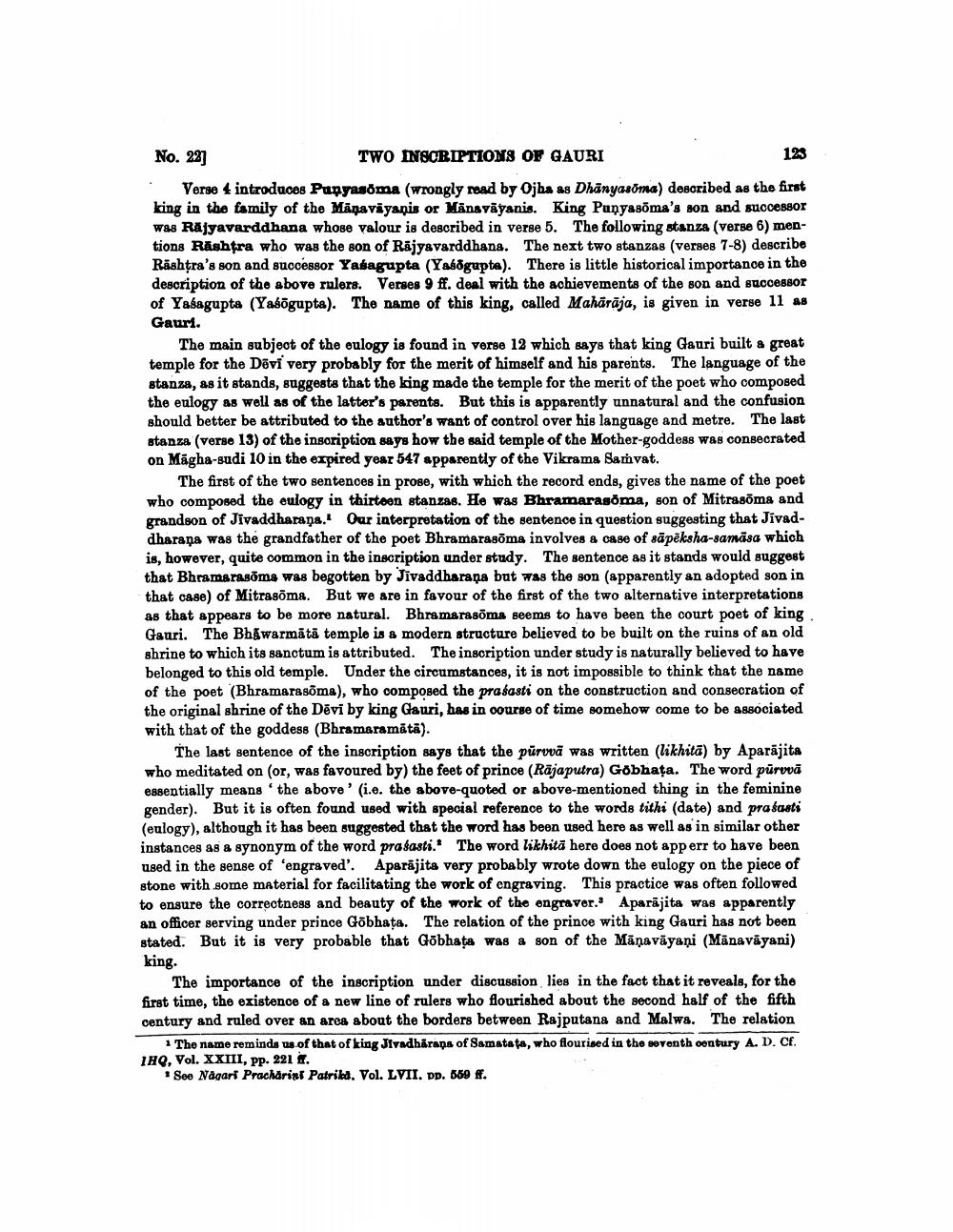________________
No. 27]
TWO INSCRIPTIONS OF GAURI
123
Verse 4 introduces Punyasoma (wrongly read by Ojha as Dhanyasoma) described as the first king in the family of the Manavayanis or Manavayanis. King Punyasōma's son and successor was Rajyavarddhana whose valour is described in verse 5. The following stanza (verse 6) mentions Rashtra who was the son of Rajyavarddhana. The next two stanzas (verses 7-8) describe Rashtra's son and successor Yasagupta (Yasögupta). There is little historical importance in the description of the above rulers. Verses 9 ff. deal with the achievements of the son and successor of Yasagupta (Yasögupta). The name of this king, called Mahārāja, is given in verse 11 as Gauri.
The main subject of the eulogy is found in verse 12 which says that king Gauri built a great temple for the Devi very probably for the merit of himself and his parents. The language of the stanza, as it stands, suggests that the king made the temple for the merit of the poet who composed the eulogy as well as of the latter's parents. But this is apparently unnatural and the confusion should better be attributed to the author's want of control over his language and metre. The last stanza (verse 13) of the inscription says how the said temple of the Mother-goddess was consecrated on Magha-sudi 10 in the expired year 547 apparently of the Vikrama Samvat.
The first of the two sentences in prose, with which the record ends, gives the name of the poet who composed the eulogy in thirteen stanzas. He was Bhramarasoma, son of Mitrasoma and grandson of Jivaddharana. Our interpretation of the sentence in question suggesting that Jivaddharana was the grandfather of the poet Bhramarasōma involves a case of sāpēksha-samāsa which is, however, quite common in the inscription under study. The sentence as it stands would suggest that Bhramarasoma was begotten by Jivaddharana but was the son (apparently an adopted son in that case) of Mitrasoma. But we are in favour of the first of the two alternative interpretations as that appears to be more natural. Bhramarasōma seems to have been the court poet of king Gauri. The Bhawarmātā temple is a modern structure believed to be built on the ruins of an old shrine to which its sanctum is attributed. The inscription under study is naturally believed to have belonged to this old temple. Under the circumstances, it is not impossible to think that the name of the poet (Bhramarasōma), who composed the prasasti on the construction and consecration of the original shrine of the Devi by king Gauri, has in course of time somehow come to be associated with that of the goddess (Bhramaramātā).
The last sentence of the inscription says that the purvva was written (likhita) by Aparajita who meditated on (or, was favoured by) the feet of prince (Rajaputra) Gōbhața. The word purvvā essentially means the above' (i.e. the above-quoted or above-mentioned thing in the feminine gender). But it is often found used with special reference to the words tithi (date) and prasasti (eulogy), although it has been suggested that the word has been used here as well as in similar other instances as a synonym of the word prasasti. The word likhitä here does not app err to have been used in the sense of 'engraved'. Aparajita very probably wrote down the eulogy on the piece of stone with some material for facilitating the work of engraving. This practice was often followed to ensure the correctness and beauty of the work of the engraver. Aparajita was apparently an officer serving under prince Gōbhața. The relation of the prince with king Gauri has not been stated. But it is very probable that Gōbhata was a son of the Maṇavāyaṇi (Mānavāyani)
king.
The importance of the inscription under discussion lies in the fact that it reveals, for the first time, the existence of a new line of rulers who flourished about the second half of the fifth century and ruled over an area about the borders between Rajputana and Malwa. The relation
1 The name reminds us of that of king Jivadhārapa of Samatata, who flourised in the seventh century A. D. Cf. 1HQ, Vol. XXIII, pp. 221 .
* See Nagari Pracharini Patrika. Vol. LVII. DD. 559 ff.




